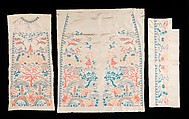Evening coat
Textile design attributed to Sarah Lipska Polish
Not on view
This object is from a collection of sample embroideries, which was originally owned by Morris de Camp Crawford, editor of Women's Wear Daily, who collected objects which told the story of fashion and fabric history. Included in this collection was a group of textiles which illustrated what American and French designers and manufacturers were using. According to Crawford's book The Ways of Fashion, the work of Polish artist Sarah Lipska (1882-1973) was represented in this collection. Lipska is an enigmatic figure, who is known to have worked with Leon Bakst as a set and costume designer for the Ballets Russes, and later in the 1920s as a fashion designer in Paris at 4 rue Belloni, and finally as a sculptor. Extant examples of her work are rare. Although only a few pieces in the Brooklyn Museum collection bear a label or a signature, others bear hallmarks of her work, such as a distinctive form of whip stitching on appliqué work, unusual abstract motifs, and Cubist-inspired patterns.
Orientalism or Chinoiserie was a common source of inspiration for design motifs in the 1920s that drew from Asian dress and decorative arts. Because of her work with the Ballets Russes, which performed many Orientalism-inspired ballets, many of Lipska's designs reflect an Orientalism influence. This particular design for an evening coat is out of the ordinary for its type, featuring fanciful motifs such as men wearing pigtails, and life-like pine trees. Other motifs seen, such as the cranes in flight, the cherry blossoms and the peaked-roof houses are ubiquitous in Chinoiserie decoration. The work is executed in delicate chain stitch using sophisticated shades making the rendering an unusually elegant and artistic example of a fairly common form.
This image cannot be enlarged, viewed at full screen, or downloaded.
This artwork is meant to be viewed from right to left. Scroll left to view more.



